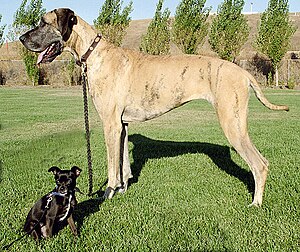Dog breed: Difference between revisions
imported>Nancy Sculerati MD No edit summary |
imported>Nancy Sculerati MD No edit summary |
||
| Line 1: | Line 1: | ||
[[Image:IMG013biglittledogFX wb.jpg|thumb|right|This [[Chihuahua (dog)|Chihuahua]] [[mixed-breed dog|mix]] and [[Great Dane]] show the wide range of dog breed sizes.]] | [[Image:IMG013biglittledogFX wb.jpg|thumb|right|This [[Chihuahua (dog)|Chihuahua]] [[mixed-breed dog|mix]] and [[Great Dane]] show the wide range of dog breed sizes.]] | ||
A '''dog breed''' is a group of [[dog]]s that share very similar | A '''dog breed''' is a group of [[dog]]s that share a set of very similar features. The features that define a dog breed include appearance and behavior. All dog breeds are the same species, and can mate and produce offspring. The features that distinguish breeds do so in the minds of humans, but not all dog breeds were bred by people purposefully mating dogs of like characteristics. Some are natural breeds, that came about because a group of dogs were isolated from other dogs by a geographic feature, and over the generations produced a group of animals of a recognizeable type. These breeds, called [[natural breeds]], often came about in mountainous areas or islands. | ||
Dogs have been [[selective breeding|selectively bred]] for specific characteristics for thousands of years. Initially the selections would have centered on [[domestication]] and useful behavior such as [[hunting]] ability. Later, dogs were also selected for attractive and distinctive forms, resulting in a vast variety of types. | |||
"The archeologic record suggests that the first domestic dogs are found in the Middle East approximately 14,000 years ago".(reference for quote:Robert K. Wayne, Elaine A. Ostrander: Origin, genetic diversity, and genome structure of the domestic dog BioEssays Volume 21, Issue 3, Date: March 1999, Pages: 247-257). | "The archeologic record suggests that the first domestic dogs are found in the Middle East approximately 14,000 years ago".(reference for quote:Robert K. Wayne, Elaine A. Ostrander: Origin, genetic diversity, and genome structure of the domestic dog BioEssays Volume 21, Issue 3, Date: March 1999, Pages: 247-257). | ||
Revision as of 17:19, 18 January 2007
A dog breed is a group of dogs that share a set of very similar features. The features that define a dog breed include appearance and behavior. All dog breeds are the same species, and can mate and produce offspring. The features that distinguish breeds do so in the minds of humans, but not all dog breeds were bred by people purposefully mating dogs of like characteristics. Some are natural breeds, that came about because a group of dogs were isolated from other dogs by a geographic feature, and over the generations produced a group of animals of a recognizeable type. These breeds, called natural breeds, often came about in mountainous areas or islands. Dogs have been selectively bred for specific characteristics for thousands of years. Initially the selections would have centered on domestication and useful behavior such as hunting ability. Later, dogs were also selected for attractive and distinctive forms, resulting in a vast variety of types. "The archeologic record suggests that the first domestic dogs are found in the Middle East approximately 14,000 years ago".(reference for quote:Robert K. Wayne, Elaine A. Ostrander: Origin, genetic diversity, and genome structure of the domestic dog BioEssays Volume 21, Issue 3, Date: March 1999, Pages: 247-257).
Many traditional dog breeds recognised by the main breed registries are said to be "purebred". Only individuals whose parentage consists only of other purebred examples of the breed are regarded as part of that breed. This concept has caused controversy both because of the difficulty of regulation and because of the possible genetic consequences of a limited population (inbreeding). Recent work has been done to genetically classify the various breeds, with some surprising results regarding the estimated age and interrelations of the breeds.
Recognizing a new breed
The point at which a new variety becomes a breed can be difficult to decide. National kennel clubs often differ in their recognition of breeds and rare breeds might not be recognised outside their home country. Usually, only dogs recognized by a kennel club are eligible to compete in that specific club's conformation shows and dog sports, although many dog sports allow any healthy dog to compete regardless of the breed.
Generally, before a type of dog is recognized as a breed, it must be shown that mating a pair of that type always produces dogs that have the same characteristics as the parents, usually both in appearance and in behavior. This is known as breeding true. There are many issues concerning what is considered breeding true. For example, Flat-Coated Retrievers must always be black; however, yellow coats occur occasionally in some litters. Kennel clubs do not recognize the yellow dogs as legitimate members of the breed; some breeders will kill the puppies rather than risk having the dog grow up, breed, and produce more of the undesired yellow color, perpetuating the undesireable gene; more often, today, such dogs are neutered and placed in homes as pets. As another example, a breeding pair of Belgian Shepherds of the Groenendael variety can produce puppies of the Tervueren (brown) variety; the AKC considers the varieties to be different breeds and, therefore, the brown puppies are invalid and undesirable dogs, whereas the CKC considers them simply to be different color varieties of the same breed.
See selective breeding for a detailed discussion on open versus closed stud books and some of the issues concerning purebreds.
See also
External links
- Livestock Guard Dogs: What is a Breed and Why Does It Matter?
- AKC Dog Registration Statistics for 2003 and 2004
da:Racehund de:Hunderasse nl:Hondenras no:Hunderase pl:Rasy psów sr:Расе паса sv:Hundras
